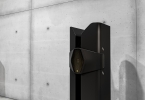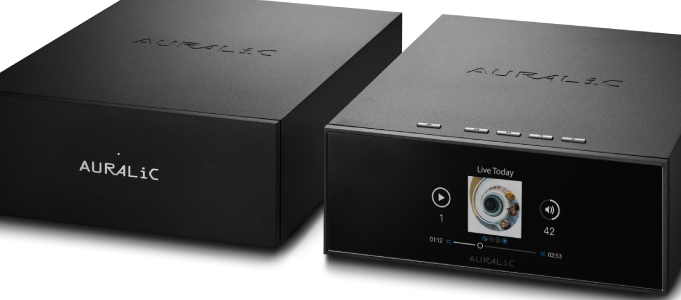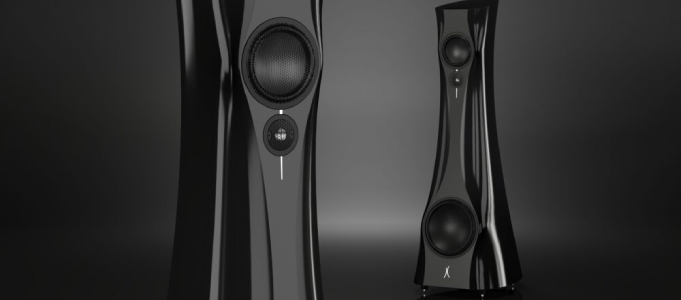Monitor Audio Hyphn Loudspeakers Review

David Price auditions one of the most impressive and innovative new high-end loudspeakers that he’s heard in a long time…
Monitor Audio
Hyphn Loudspeakers
AUD $135,000 RRP

“A peerless, definitive, uncompromising demonstration of the company's current design, engineering and manufacturing capabilities, and its future ambitions.” So says Monitor Audio Group's head honcho, Rob Barford, about his company's new flagship loudspeaker – and I don't think you could be clearer than that!
This unconventional looking large floorstander is interesting on many levels. Not only does it bring much original thinking to the problem of creating a truly neutral and transparent monitor, but it's also totemic of the wide and deep changes that have been happening in the Monitor Audio Group in the past few years. The company is wholly British-owned and independent, so not beholden to parent companies wanting a quick return for their money, Rob told me in his recent interview. And that is why it was possible to spend over three years making the new Hyphn. It was conceived as a celebration of Monitor Audio's fiftieth anniversary and something to set out the company's vision – what Global Marketing Director Michael Johnson calls “a North Star product”.
“Hyphn is unlike anything we, or anyone else, has ever created: the most creatively ambitious, technically advanced, and powerful loudspeaker in the history of Monitor Audio Group. It's a definitive demonstration of the capabilities we've developed over our first five decades”, he says. This is effectively the production version of the Concept 50 prototype released in 2022 and retails in Australia for $135,000. It puts the company into the 'ultra high end' sector, a place it has never been before, where there's simply no excuse for any failings, and competition is cutthroat. That's no easy challenge for a speaker brand widely associated with products at one tenth – or even one hundredth – of the price.

There is a lot going on beneath the Hyphn's striking facade – this speaker is far from being just a style statement. Indeed, Monitor Audio's Product Design Director Charles Minnet would argue that it's very much a case of form following function, and that the large design team couldn't have made it any other way in order to get the desired result. Yet just as striking is the very existence of this product – in other words, why was it conceived in the first place, and what type of buyer is it aimed at?
“Hyphn is not a big speaker for its price and performance”, Michael Johnson tells me. “We purposely designed it to be approachable, and although unique it does not overly dominate a space. It was key to us that we designed something that could be used and enjoyed. After all listening to the very best speakers should not be just for those who have the space for a dedicated listening room, although I'm sure this is where a lot will end up living. While our obvious competitors are the likes of B&W, KEF, Focal, etc., we did not focus on what they were doing during the development stage. Instead, we had a clear vision of what we wanted to do and I think this comes out in this speaker's design.”

IN DEPTH
At the heart of the Hyphn is the so-called 'M-Array', which is the brainchild of Technical Director, Michael Hedges. It is a cluster of six 50mm midrange drivers, surrounding the single Micro Pleated Diaphragm III ribbon-type tweeter, as already seen in the Platinum Series 3G floorstanding loudspeaker. The midrange drivers feature Monitor Audio's Rigid Diaphragm Technology III cones, introduced last year. The idea is to have a virtual point source, where the lion's share of the frequency range emanates from one place in space. Having six dinky drivers means you can locate them very close to the tweeter, creating the equivalent of a coaxial treble/mid driver. The total surface area of the six small transducers is about 75cm2, which is approximately equivalent to the surface area of two midrange drivers from Monitor Audio's Silver range, or a single Platinum midrange driver.
Michael Johnson explains: “Having six individual drivers means that power handling is extremely high, giving a lot of headroom before thermal compression kicks in. The small cones and surrounds mean that any cone breakup or surround resonances are pushed well above the crossover to the tweeter. For example midrange output is smooth to well over 10kHz while the mid to tweeter crossover is around 3kHz, this allows for a smooth crossover between the drivers which helps the overall frequency response, while the off-axis performance remains consistent and smooth.”

The single Micro Pleated Diaphragm III ribbon-type tweeter has an extremely light and very thin Polyimide diaphragm – just 0.0125mm thick – with an aluminium conductor that's just 0.02mm thick laminated to it. It's said to have a similar acoustic source size to a 25mm dome tweeter, but with a surface area four times greater than the opening in the faceplate of the tweeter. This means it moves far less than a dome for the same sound pressure level, Monitor Audio says. This makes for lower distortion and greater linearity than a conventional dome tweeter, plus faster transient speed.
The four 200mm RDT III bass units in every speaker divide up into two vertically opposed pairs. Each driver is built-in to one of the two pillars, firing at the other one on the inside of the other pillar. This is said to create a force-cancelling effect, “resulting in almost no vibration force from the drivers, either within themselves or being passed into the cabinet.”
Michael Johnson continues: “We've chosen what we felt was the very best technology for each element of the design… For example, for the bass we wanted deep controlled bass so we engineered a cabinet construction and driver arrangement to deliver on this. The ported cabinet is tuning is very low at 25Hz, this means that the speaker acts more like a closed box above about 35Hz, giving it fast and responsive bass but also bass that can dig deep, while the force cancelled arrangement reduces cabinet vibrations ensuring the upper bass is clean.”

The Hyphn's big (1,392x502x520mm, 107kg) twin-pillar cabinet is not huge by high-end standards, but is certainly novel. Constructed in thermoformed, precision-milled “mineral and acrylic stone”, it's said to create a totally rigid structure. It has built-in formed, port tubes, strengthening ribs and bracing, and internal and external wall thickness of between 12.5mm and 25mm. The Hyphn takes its name from the architectural term 'hyphen', which is a link connecting two separate structures – referring, of course, to the cabinet's twin pillar orientation, with the 'hyphen' between them housing the M-Array. It's offered in Pure Satin White, Matte Black, and Matte Heritage Green finishes, with contrasting trim details.
Last but not least is the crossover, which is said to have been developed in conjunction with the design of the eleven drive units and cabinet rather than being an afterthought. It's a three-way design that works at 350Hz and 3.7kHz, with each section mounted on its own board, which is spaced from the others to reduce crosstalk. These are then mounted to the cabinet using rubber-isolated mounts, while each component value and type has been carefully selected. Each crossover consists of over thirty components; the capacitors are all custom Clarity Caps, the inductors for the midrange and treble sections are all air core, and for the bass section, large steel core inductors are fitted with very thick copper wire to keep resistance as low as possible. Internal wiring is also copper wire, of the 4mm2 OFC variety.

In terms of matching, you'll need a source and amplification befitting a speaker of this price. The real focus is the amplifier, which will be asked to drive something with a 4-ohm nominal impedance at high levels, despite a so-so sensitivity figure of 86dB/1m/2.83v. That's not an impossible ask, of course, and the weird world of high-end hi-fi has plenty of more demanding speakers around. Just be mindful that you can't get away with a 3-watt parallel single-ended valve amplifier – it's solid-state muscle amps that will do best with the Hyphn. Michael Johnson says: “It requires an amplifier that has a bit more power for normal listening levels. We've taken this decision because, at this price point, larger amplifiers are common, and the lower sensitivity is partly what enables the size of the speaker while maintaining the very low bass extension”. Frequency response is a claimed 18Hz to 60kHz (-6dB).

THE LISTENING
As soon as you hear the Hyphn, it is clear that the Monitor Audio design team has gone for a sound that combines the openness and transparency of the best electrostatic or ribbon designs, allied to the gutsy, powerful bass you would expect from large box speaker. Indeed, this reminds me of a hybrid MartinLogan in several respects – a high-end design that employs a big electrostatic midrange and treble panel, bolstered by a moving coil bass driver for low-frequency duties. Yet I think it's actually more subtle and integrated sounding – indeed, it is remarkably seamless from bottom to top, and there's no sense of any of its multiple drive units competing with one another. Bass is nowhere near as huge as some monster high-end speakers I've heard – like JBL's superb Everest DD67000, for example. Yet somehow, it doesn't need to be, as the bottom end is so tight and tuneful, and melds almost magically into the gloriously open, detailed and delicate midband.
The result is that you find yourself listening to music in a different way than you would with lesser loudspeakers. There is so much information being presented in front of you that it becomes a choice of what you choose to take in. Rather like a huge buffet-style lunch, you find yourself wandering around sampling things, and taking them away for further investigation. The Hyphn lets you closely follow individual elements of the mix, fixating on the beauty of specific things like a lead vocal line, for example. The clarity is almost spooky, as it feels like you're right there in the room with the musicians. As per the best electrostatics or ribbons, the sound is incredibly intimate, but it has more bass ballast and dynamic headroom than panel designs.

It is the superlative combination of insight, intimacy and integration that makes the Hyphn such a pleasure. For example, I found myself transfixed by Sia Furler's vocals in Zero 7's downtempo masterpiece, Destiny. This slow, dreamy torch song with a placid groove can sound downright boring through mediocre equipment. Yet the Monitor Audio's pin-sharp midband was a revelation. The recording is actually a little brittle in tonal terms, and sounds quite well lit in the upper midband – if not quite outright bright. It's also highly processed and dynamically compressed, to add to the misery. Such things do not make it easy for speakers, but the Hyphn proved totally unfazed. Furler's dulcet, smouldering vocals are heavily stylised and sometimes on some systems, it's easy to miss the exact words that she's singing, but not with this loudspeaker. It threw a strong white light into the mix, illuminating it to the point where everything came into sharp relief.
Female vocals sounded so intimate that I almost felt embarrassed to be in the same room at times, like I was invading someone's personal space. In the choruses, singer Sophie Barker joined in to deliver beautiful harmonies which the Hyphn caught superbly. The electronic backing sounded thick and sumptuous, with a wonderfully snappy drum machine sound powering the hypnotic groove along in the background. The overall effect was quite mesmerising, and rarely heard through any other loudspeaker I've experienced. I could clearly hear the studio-overdubbed' groove crackle' playing through the song's opening segment, then disappear as soon as the vocals kicked in – another nice surprise.

It's the Monitor Audio's combination of superb driver integration, along with the physicality of conventional big box loudspeakers, that makes it such an interesting design. Those four bass units don't draw attention to themselves and instead subtly 'pad out' the midband rather than try to upstage it. The bottom end is never overblown, but at the same time, you wouldn't ever call it anaemic. Nicely fluid, it modulates up and down with ease; indeed on the right programme material, it sounds really notchy and gnarly, yet with no overhang or bloat.
This is a really confident sounding speaker with an exceptionally wide bandwidth. Its bass response never overpowers but is properly muscular, while its treble performance is sweet, atmospheric and ethereal. The early nineties hardcore electronica of Nookie's Give A Little Love showed the Hyphn to have no shortage of power at either end of the frequency spectrum. This track goes almost as low as the bottom note on a church organ, and this speaker had a serious go at reproducing the sub-bass throughout the track. It was never boomy, though, and when pulled a metre or so out from the boundary wall, the upper bass was, if anything, on the light side. Up top, hi-hat cymbals from the drum machine were deliciously delicate, but had real, visceral bite.

The Hyphn's super-detailed, ultra-low distortion sound will soon have you running the gamut of your music collection and playlists. Its glass-clear midband seems to make everything you listen to sound fresh, shiny and new – even recordings that I've heard seemingly a million times were fascinating to behold. ABBA's Dancing Queen was joyous; we all know it's pretty low-fi as recordings go and can sound coarse through serious systems that don't mask the detail. Yet again, the Hyphn made it special. This combination of female voices is uniquely distinctive; there'a a kind of metal to the sound of Frida's mezzo struggling to get up to Agnetha's soprano. This upper midband region is right where hi-fi loudspeakers often crossover between drive units, and also where Class AB power amplifiers can manifest their switching distortion. Yet here, the music was so delicate and even, and each of these great singers had a lovely timbre to their voice.
Those super light, low-distortion drive units work their magic in different ways, too. As well as uncanny clarity, there's a great rhythmic positivity to the Hyphen. That's why you can cue up what is basically a very poor, low-fi recording and still get masses out of it. Bobby Womack's Across 110 Street is just such a thing – a beautiful slice of early seventies soul and/or rare groove, it sounds like it was recorded in a tunnel. Yet the big Monitor Audio wasn't in the least bit bothered. Its innate clarity told me that the recording equipment was primitive, but it picked through all the production muddle like a hot knife through butter to reveal everything that was going on. More importantly, it carried the natural groove of the music – something that was quite emotional coming from the brilliant session players on this track. The speaker locked on to the way Womack syncopated his voice with the rhythm section, using it in percussive as well as a melodic manner. At the same time, it made the most of the song's anaemic-sounding bassline, serving up a highly propulsive bottom end that moved more air around the room than expected.

This speaker's control is amazing; it's one of the best I've ever come across in terms of being able to latch onto one particular strand of the mix and follow it right through the song. And at the same time, every strand of the mix is placed in space with laser precision. Theme From Boat Weirdos by Joe Walsh – a quirky slice of late seventies US rock – is a clean and crisply recorded song that is superficially quite simple but has a lot going on. I was surprised by the pin-sharp location of the lead electric guitar inside the recorded acoustic, and how it pushed ahead of the closely miked flutes and backing synth glides. The song starts simple, then gains layers of instruments, all of which play together to produce a sophisticated arrangement. The Hyphn simply unpeeled it like an onion, so to speak; I could hear layer upon layer of production details, such as the violin playing all the way through the track, where so often with other speakers, it gets subsumed. Likewise, I heard birds chirping right at the back of Marillion's Garden Party with a precision that I hadn't previously experienced.
So there's a litany of things for the Hyphn to boast about; it's undeniably a great loudspeaker. Indeed, it's hard to pinpoint exactly what's best about it, such are its many talents. For me, it's the midband clarity that's truly special, but it is actually a great all rounder in every respect from stereo soundstaging to its ability to handle loud dynamic swings effortlessly. Many high-end speakers tend to be designed to focus on specific aspects of performance, whereas this is excellent across the board. My only caveat is that it's not a massive air mover, and lacks true room-wrecking bass – so those with enormous listening rooms might want something more barrel-chested. This said, the Hyphn fits effortlessly into any medium-to-large listening space, which was, of course, a core part of its design remit.

THE VERDICT
 To my ears, this is a great loudspeaker – and better still, it's not another 'me too' design either visually or sonically. To my eyes, it looks rather quirky in an elegant sort of way, but that's merely a function of how it has been designed to get the sound that Monitor Audio wanted. The Hyphn is a bold and innovative product that doesn't really sound like anything else on the market. It is highly analytical – forensic even – but absolutely never boring. Its super low distortion sound permits prolonged high-volume listening without fatigue, and it's wonderful for immersing yourself deep into your favourite recordings and getting submerged in the mix. If you have this sort of money to invest in your 'ultimate' loudspeaker, then this is an essential audition. As for the wider industry politics of it all, if this doesn't put Monitor Audio firmly on the super-fi map, then I am not sure what will.
To my ears, this is a great loudspeaker – and better still, it's not another 'me too' design either visually or sonically. To my eyes, it looks rather quirky in an elegant sort of way, but that's merely a function of how it has been designed to get the sound that Monitor Audio wanted. The Hyphn is a bold and innovative product that doesn't really sound like anything else on the market. It is highly analytical – forensic even – but absolutely never boring. Its super low distortion sound permits prolonged high-volume listening without fatigue, and it's wonderful for immersing yourself deep into your favourite recordings and getting submerged in the mix. If you have this sort of money to invest in your 'ultimate' loudspeaker, then this is an essential audition. As for the wider industry politics of it all, if this doesn't put Monitor Audio firmly on the super-fi map, then I am not sure what will.
For more information visit Monitor Audio
David Price
David started his career in 1993 writing for Hi-Fi World and went on to edit the magazine for nearly a decade. He was then made Editor of Hi-Fi Choice and continued to freelance for it and Hi-Fi News until becoming StereoNET’s Editor-in-Chief.
Posted in:StereoLUX! Hi-Fi Loudspeakers Floor Standing Applause Awards 2023
Tags: monitor audio interdyn
JOIN IN THE DISCUSSION
Want to share your opinion or get advice from other enthusiasts? Then head into the Message Forums where thousands of other enthusiasts are communicating on a daily basis.
CLICK HERE FOR FREE MEMBERSHIP
Trending
applause awards
Each time StereoNET reviews a product, it is considered for an Applause Award. Winning one marks it out as a design of great quality and distinction – a special product in its class, on the grounds of either performance, value for money, or usually both.
Applause Awards are personally issued by StereoNET’s global Editor-in-Chief, David Price – who has over three decades of experience reviewing hi-fi products at the highest level – after consulting with our senior editorial team. They are not automatically given with all reviews, nor can manufacturers purchase them.
The StereoNET editorial team includes some of the world’s most experienced and respected hi-fi journalists with a vast wealth of knowledge. Some have edited popular English language hi-fi magazines, and others have been senior contributors to famous audio journals stretching back to the late 1970s. And we also employ professional IT and home theatre specialists who work at the cutting edge of today’s technology.
We believe that no other online hi-fi and home cinema resource offers such expert knowledge, so when StereoNET gives an Applause Award, it is a trustworthy hallmark of quality. Receiving such an award is the prerequisite to becoming eligible for our annual Product of the Year awards, awarded only to the finest designs in their respective categories. Buyers of hi-fi, home cinema, and headphones can be sure that a StereoNET Applause Award winner is worthy of your most serious attention.























